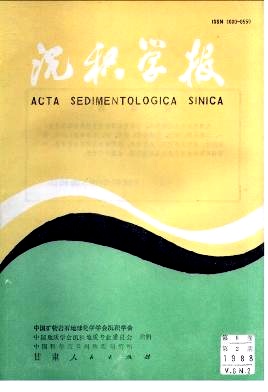Qiu Dongzhou. A SEDIMENTARY CLASSIFICATION OF MESO-CENOZOIC CONTINENTAL BASINS IN CHINA[J]. Acta Sedimentologica Sinica, 1988, 6(2): 50-60.
| Citation:
|
Qiu Dongzhou. A SEDIMENTARY CLASSIFICATION OF MESO-CENOZOIC CONTINENTAL BASINS IN CHINA[J]. Acta Sedimentologica Sinica, 1988, 6(2): 50-60.
|
A SEDIMENTARY CLASSIFICATION OF MESO-CENOZOIC CONTINENTAL BASINS IN CHINA
- Received Date: 1986-10-28
- Publish Date:
1988-06-10
-
Abstract
According to three principle factors controlling sedimentation of a basin (inundation of waters, changes of climate and structural movement), the continental basins in China can be classfied into two groups, each of them can be divided into three types respectively, and each of types can be differentiated into three species further. Normally and abnormally continental basins 1. Normally continental basins (type Mo) They developed in the interior of continent where were far from the coast and a higher elevation relatively. The transgression did not affcet the depositional process. The main factors that controlled the deposition were continental structure, climate, hydrology and organisms. The dark clays and carbonates deposited in these basins under humid and semi-dry climate have the ability of generating oil and gas in some extent. 2. Abnormally continental basins (type M1) They developed in the area where were offshore or lower elevation. The transgression affected the depositional process. Their properties of deposition, geochemistry and organisms have both characteristics of marine and continental facies. They were connected with sea or connected intermittently by channel. The clays and carbonates formed in transgression are favourable source rocks. The sand bodies formed in regression have fair reserviors. Basins developed under arid, moist and transition climate 1. Basins developed arid condition (type C1) Their characteristics are that they contain red clastic rocks, carbonates, sulphate rocks and chlorate minerals. The species of organisms is monotonous. A fair thickness of the source rock deposited in these basins while the supply of the sea water increased or the evaporating amount of the water decreased and basins sank continously. 2. Basins developed under moist condition (type C2) Their characteristics are that they have a large amount deposits derived from swamp envirnoment. Dark clays in the basins are good source rocks. Fluvial and delta sand bodies are considered to be reserviors. 3. Basins developed under transitional climate (type C3) The characteristics of deposition, geochemistry and organisms are between that of the arid basins and the moist basins. The deposits deposited in these basins are common source rocks. Faulted basins, depressional basins and faulted-depressional basins 1. Faulted basins (type S1) The process of generation and development of basins was mainly controlled by fault. Thicker source rocks would be deposited when basins was deficient of deposits, and a lithologic and structural oil poll would be formed when source rocks deposited well with fair reserviors in this area. 2. Depressional basins (type S2) Their generation and development were controlled mianly by depression. The lithology and lithofacies changed steadily. The source rock-reservior-cap rock relationship is fairly good. It contains big oil-gas accumulations usually. 3. Faulted-depression basins (type S3) The generation was controlled by mechanism of faulted-depression and depressional basin. The characteristic3 of deposits and oil gas are between type S1 and type S2. In conclusion, a classfication of basins according to three factors controlling the sedimentation of basins, is singificant for forecasting oil and gas prospect.
-
References
|
[1]
|
丘东洲等,1986,中国西北地区中新生代陆盆沉积模式研究的几个问题,岩相古地理文集(二),地质出版社。 |
|
[2]
|
丘东洲等,1986,中国中新生代陆盆沉积模式与油气,中国中新生代陆相盆地发育沉积与油气,石油工业出版社。 |
|
[3]
|
丘东洲等,1984,中国早期第三纪非正常陆与油气,国际交流地质学术文集(为廿七届国际地质大会撰写),199-208页。地质出版社。 |
|
[4]
|
丘东洲等,1982,石油与天然气地质,3卷4期,343-35。页。 |
|
[5]
|
黄弟藩等,1984,陆相有机质演化和成烃机理,1 -17页,石油工业出版社。 |
|
[6]
|
汪品先等,1980,海洋微古生物论文集,30-38页,海洋出版社。 |
|
[7]
|
丘东洲,1985,塔里木盆地西部中新世含膏碎屑岩沉积模式与油气,蒸发岩与油气,42-49页,石油工业出版社。 |
|
[8]
|
同济大学海洋地质系编,1980,海陆相地层辩认标志,159-172页,科学出版社。 |
|
[9]
|
周光甲,1984,石油与天然气地质,5卷2期,156-167页。 |
|
[10]
|
江继纲等,1982,石油与天然气地质,3卷1期,1 -15页。 |
|
[11]
|
中国科学院兰州地质所,1980,中国陆相油气田的形成演化和运移,35-36页,甘肃人民出版社。 |
|
[12]
|
关士聪等,1983,石油与天然气地质,4卷4斯,423-430页。 |
|
[13]
|
丘东洲,1986,新疆地质,4卷1期。 |
-
-
Proportional views

-






 DownLoad:
DownLoad: